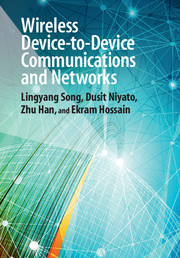Book contents
- Frontmatter
- Dedication
- Contents
- Preface
- Part I Introduction
- Part II Techniques for modeling and analysis of D2D communications
- Part III Resource management, cross-layer design, and security for D2D communications
- Part IV Applications of D2D communications
- Part V Standardization of D2D communications
- 12 Network-controlled D2D over LTE/LTE-A
- References
- Index
12 - Network-controlled D2D over LTE/LTE-A
from Part V - Standardization of D2D communications
Published online by Cambridge University Press: 05 March 2015
- Frontmatter
- Dedication
- Contents
- Preface
- Part I Introduction
- Part II Techniques for modeling and analysis of D2D communications
- Part III Resource management, cross-layer design, and security for D2D communications
- Part IV Applications of D2D communications
- Part V Standardization of D2D communications
- 12 Network-controlled D2D over LTE/LTE-A
- References
- Index
Summary
This chapter mainly introduces the motivation and requirement for using D2D communications over Long Term Evolution (LTE)/LTE-Advanced (LTE-A). The agreed working scenarios and working assumptions are discussed and also the methods for link-and system-level performance evaluation are provided.
D2D communications in LTE-A networks
Now that more and more new multimedia-rich services are becoming available to mobile users, there is an ever-increasing demand for higher-data-rate wireless access. As a consequence, new wireless technologies such as LTE have been introduced. These technologies are capable of providing high-speed, large-capacity, and mobile services with guaranteed quality of service (QoS) [183]. With the technological evolution of cellular networks, new techniques, such as small cells, which are able to improve network capacity by reducing cell size and effectively controlling interference, have been developed. However, most attempts still rely on the centralized network topology which requires mobile devices to communicate with an evolved Node B (eNB). Such a centralized network topology can easily suffer from congestion with a large number of communicating devices. Additionally, the eNB might not have complete information about transmission parameters among devices, which is required in order to achieve optimal network performance. Consequently, the concept of D2D communications has been introduced to allow local peer-to-peer transmission among mobile devices by bypassing the eNB and AP [1].
Many technical groups such as the 3GPP and the IEEE are currently addressing the standardization of D2D communications in the licensed band. A major breakthrough was achieved in due course when the 3GPP agreed on starting a study item for D2D technology. The objective of this study item is to investigate the operator-controlled communications between user equipments (UEs) that are in proximity, under continuous network control, and in 3GPP network coverage. Specifically, besides cellular operation, where the UEs can be served by the network via the eNB in the LTE system, some UEs may communicate with each other directly over direct links for proximity services [381].
- Type
- Chapter
- Information
- Wireless Device-to-Device Communications and Networks , pp. 371 - 389Publisher: Cambridge University PressPrint publication year: 2015



